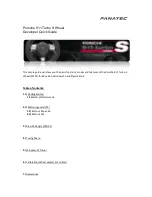
Unit 2 Use and Notices
2.1
Basic Knowledge for New Car Use
2.1.1 Checking the new car
In order to ensure safe driving, before using the car, it must be checked as follows:
(1) Check the connection and strength of the key and essential parts to see whether they accord with
requirements, especially on steering devices and braking system. For example, universal joint boot, bed plate,
brake system, wheels, steering tie rod boot, steering boot, transmission and so on.
(2) Check the specification, models and quantity of all the oil and liquid to see whether they accord with
requirements, such as gasoline, lube, cooling liquid, electrolyte, air window washer fluid, brake liquid,
transmission oil, brake oil, steering oil and so on. And also check the car
leaks oil and water or not.
(3) Check the working condition of battery voltage, electrical system, lamplight, horn, instrument, pilot lamp
and so on. And also check the installment of fuse wire in driver’s cab.
(4) Check the types, specifications and tread of the tyres to see whether they comply with requirements;
check the tightening torque of the bolt to see whether it comply with the demanding requirement; check each
tyre’s air inflating pressure to see whether it is normal (including spare tyre) and check the installment of inner
valve and the coverings of wheel.
(5) Check the connection and strength of each part, especially the parts of driving, steering, braking,
suspension, wheels and so on.
(6) Check clutch, and free stroke of pedal to see whether they accord with the specified value; check the
brake system and free stroke of braking pedal to ensure that air in the pipeline is exhausted.
(7) Check the cleanliness of the exterior, including: paint, decorating parts and glass; check the cleanliness of
the interior, including: seats, inner decoration parts; check the state of windscreen cleaning device.
(8) Start the engine, warm it up till it reaches the normal temperature, then check it to see whether there is
any leakage of oil, gas, water and electricity.
(9) After running with the gearshift lever in gear, check the working condition of clutch, transmission, hand
braking, foot braking, steering system and so on.
1) Clutch: whether there is a stuck noise
or
disordering noise.
2) Speeding-up pedal: flexible as well as non-loosening.
3) Transmission: freely changing gear without difficulty or out-of-gear.
4) Odometer: the odometer index is not chattering while running; when speed changes, the index should
waggle stably.
5) Steering control mechanism: we should check whether free stroke of steering wheel is normal, and
whether it can automatically back to its position after turning.
6) Foot braking: when braking at speed of 40km/h, we can feel the braking impact, and stop without
deflection.
7) Hand braking: when we are lifting the handle of hand braking, and driving at low speed of 20km/h,
we can feel the braking impact while transmission getting into neutral position.
8) Air condition: operate buttons and check whether they are in normal working.
9) Judge each part to see whether the sound is normal: when the car is running, especially speeding up
or slowing down, please pay much attention to whether there is obviously disordering sound.
10) Check the car to see whether the tools and required technical materials are complete along with it.
11
)
The air in the water tank and engine must be brought out first.
2.1.2 Breakingin of the new car
Because of the oversight of processing and assembling, friction resistance between moving parts, at the
beginning of working, is stronger than at the normal occasions. The effect of breakingin during early period of





































